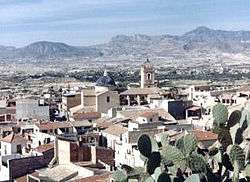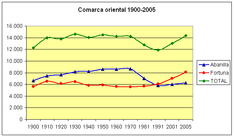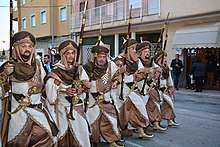Abanilla
Abanilla is a Spanish municipality located in the Comarca Oriental (composed by Fortuna and Abanilla) in the Autonomous Community of Murcia. It lies close to the border of the province of Alicante in the Autonomous Community of Valencia.[2]
Abanilla | |
|---|---|
 | |
| Coordinates: 38°12′N 1°3′W | |
| Country | Spain |
| Province | Murcia |
| Comarca | Comarca Oriental |
| Government | |
| • Mayor | Ezequiel Alonso Gaona (PSOE) |
| Area | |
| • Total | 236.6 km2 (91.4 sq mi) |
| Elevation | 201 m (659 ft) |
| Population (2018)[1] | |
| • Total | 6,063 |
| • Density | 26/km2 (66/sq mi) |
| Post code | 30640 (Abanilla Town), 30648 (Barinas) |
| Area code(s) | 968 and 868 |
| Website | www.abanilla.es |
Geography
Abanilla occupies a surface area of 236.6 km² and is situated 222 metres above sea level.[2] It lies on a natural foundation which has been degraded by a number of aggregate and marble quarries.
Paleontological Significance
A karstic paleontological site is located on the southeast slope of the Sierra de Quibas in an abandoned limestone quarry. Researchers have discovered vertebrate and invertebrate fossils at this site.[3] They collected rodent fossils and used dental patterns to identify these to be of the Muroidea subfamily Arvicolinae. Using stratigraphic and sedimentological features in the limestone, the scientists were able to date these fossils to the Early Pleistocene subepoch.[4]
Points of interest
Points of interest in Abanilla include the Old Town (containing the monument to the Corazón de Jesús), the Fuente de Algarrobo (Fountain of the carob tree), the Santuario de Mahoya (Sanctuary of Mahoya), and the Iglesia Parroquial de San José (Parochial Church of St. Joseph). Other sights worth visiting include the source of the River Chícamo and the mountains of Abanilla and Quibas.
Monuments
Buildings of monumental significance in Abanilla include the La Iglesia de San José (the Church of San José) (18th century), El Sagrado Corazón (Sacred Heart) in Abanilla Town and Barinas, La Casa de la Encomienda, La Casa Cabrera, La Casa Pintada, El Monumento a las Fiestas de Moros y Cristianos (the Monument to the Festivals of the Moors and Christians) and La casa del francés (the French's house).[5][6][7]
There is a destroyed medieval enceinte in Abanilla.
Local communities
Local communities within the Abanilla municipality include the following.[8][9]
- Barinas, a rural town located 11 km from Abanilla town, at an elevation of 379 m.
- Macisvenda, located 10 km from Abanilla town, a crossroads of the roads to La Algueña, El Cantón, Hondón de los Frailes and Hondón de las Nieves.
- Other communities include Mahoya, El Cantón, Cañada de la Leña, El Partidor, El Tollé, Los Baños de Fortuna, Casa Cabrera, Casa Pintada, Los Carrillos, La Umbría, Collado de los Gabrieles, Ricabacica, El Algarrobo, Campules, Balonga, Mafraque and El Olivar.
History
There has been presence of human beings since the Paleolithic. Lithic workplaces corresponding to that era were found in the Southern half of the municipality.[10][11][12]
This current municipality was also inhabited by people during the first centuries of the Ancient Era (from 5th century to the 3rd in this case) by Iberians. There is a former settlement in the Norhtwest end it also occurs in Fortuna and Jumilla and another one in the south.[13]
There were also people inhabitance and structures corresponding to the period when Romans ruled the Iberian Peninsula. A roman road (via romana) traversed Abanilla and there are remains of it. Another site dating back from that era is a former Roman villa.[14][15]
A war with conquer purposes begin in the Iberian Peninsula in 711. Muslim peoples intended to rule the peninsula and conquered large part of it from the starting year to 726. The nobleman Theodemir did an agreement with the governor Abd al-Aziz ibn Musa in 713 which name is Treaty of Orihuela. Teh treaty lead Abd al-Aziz to rule territory between Vinalopó and Segura rivers. Consequently, Abanilla had dependency on Orihuela during the Muslim Iberian Peninsula era.[16]
A structure that originated in that period is the alcazaba (arabic fortification) of the town.[16]
The king of the Taifa of Murcia signed the Treaty of Alcaraz, which consisted in conferring vassalage to the Crown of Castile, in 1243. Muslims were allowed to stay, and keep their religion, customs, organisations, etc. provided they payed extra taxes. In this era, Abanilla ceases being part of Orihuela because the first one belonged to Castile and the second one to Aragon.[16]
In 1613, the king Ferdinand III of Castile ruled the expulsion of the Muslims. As there were rather many of them in Abanilla (over 1,000), the town turned out not to have enough workers for land labouring and that caused an economic downturn, which lasted for a century.[17]
There had been an increase in population in 18th century and there were over 7,000 inhabitants in that century. New dwellings and buildings were necessarily built beyond the town-surrounding wall. Many important buildings of the municipality were constructed during this century.[17]
In the third quarter of the 20th century, water canals were built in Abanilla and drinking water supply begin to exist in the municipality.[18]
Politics
The mayor of Abanilla was Álvaro Gaona (Partido Independiente) from 1979 to 1983, José Luís Cutillas Rivera (Partido Socialista Obrero Español) from 1983 to 1987, Fernando Molina Parra (Partido Popular) from 1987 to 2015 and Ezequiel Alonso Gaona (Partido Socialista Obrero Español) from 2015.
Demographics

The population of Abanilla is 6,510 as of 2011.[19]
| Demographic evolution in Abanilla 1857-2008 | |||||||||||
|---|---|---|---|---|---|---|---|---|---|---|---|
| 1857 | 1860 | 1877 | 1887 | 1897 | 1900 | 1910 | 1920 | 1930 | 1940 | 1950 | 1960 |
| 4.324 | 4.650 | 5.689 | 5.617 | 6.121 | 6.634 | 7.451 | 7.641 | 8.179 | 8.220 | 8.620 | 8.594 |
| 1970 | 1981 | 1991 | 1996 | 2001 | 2002 | 2003 | 2004 | 2005 | 2006 | 2007 | 2008 |
| 8.675 | 7.049 | 5.827 | 6.130 | 6.033 | 6.040 | 6.239 | 6.145 | 6.245 | 6.333 | 6.568 | 6.642 |
Culture
Gastronomy

Typical local dishes include home-made sausages, paella with rabbit and snails, gachasmigas. In particular, desserts include fruit from the fertile orchards, such as the region's renowned Damascus apricots. Traditional confectionery includes doughnuts, sweetbreads, muffins and typical Christmas sweets. All this is enhanced by the high quality oil pressed in local mills in the ancient custom.[6]
Festivals
The International Folklore Festival is an important event which takes place in the first week of August. Between 23 April and 9 May, the festivals of Santa Cruz take place, featuring parades of Moors and Christians. In addition, from June through to the middle of September, the various communities celebrate their own individual festivals.[6]
References
- Municipal Register of Spain 2018. National Statistics Institute.
- "Abanilla • Ayuntamiento de Abanilla" (in Spanish). Retrieved 11 August 2020.
- Piñero P; Agusti J; Blain H; et al. (2015). "Biochronological data for the Early Pleistocene site of Quibas (SE Spain) inferred from rodent assemblage". Geologica Acta. 13 (3). doi:10.1344/GeologicaActa2015.13.3.5.
- "Redalyc.Biochronological data for the Early Pleistocene site of Quibas (SE Spain) inferred from rodent assemblage" (PDF). Retrieved 10 August 2020.
- "Patrimonio en Abanilla : Web oficial turismo Región de Murcia" (in Spanish). Retrieved 10 August 2020.
- "Turismo • Ayuntamiento de Abanilla" (in Spanish). Retrieved 10 August 2020.
- "Patrimonio de Abanilla - Región de Murcia Digital" (in Spanish). Retrieved 11 August 2020.
- "Pedanías de Abanilla - Región de Murcia Digital" (in Spanish). Retrieved 10 August 2020.
- "Pedanías • Ayuntamiento de Abanilla" (in Spanish). Retrieved 10 August 2020.
- "Consejería de Cultura y Turismo - BORM". 7 August 2010. Retrieved 10 August 2020.
- "Consejería de Cultura y Turismo - BORM". 23 September 2010. Retrieved 10 August 2020.
- "Montes catalogados de Abanilla". Retrieved 10 August 2020.
- "Publicación número 15310 del BORM número 236 de 13/10/2011". Retrieved 10 August 2020.
- "Historia de Abanilla - Antigüedad - Región de Murcia Digital" (in Spanish). Retrieved 10 August 2020.
- "Historia • Ayuntamiento de Abanilla" (in Spanish). Retrieved 10 August 2020.
- "Historia de Abanilla - Edad Media - Región de Murcia Digital" (in Spanish). Retrieved 10 August 2020.
- "Historia de Abanilla - Edad Moderna - Región de Murcia Digital" (in Spanish). Retrieved 10 August 2020.
- "Historia de Abanilla - Edad Contemporánea - Región de Murcia Digital". Retrieved 10 August 2020.
- "Censos de Población y Viviendas 2011. Resultados Municipales. Población por municipios, sexo y edad". Instituto Nacional de Estadistica. Sistema estadístico europeo.
External links
| Wikimedia Commons has media related to Abanilla. |
- Official website of Abanilla
- Discussion forum for Abanilla
- Unofficial website for Abanilla
- Information on Abanilla
- International Folklore Festival in Abanilla
- Knights and Damsels of Calatrava
- Association of the Knights and Damels of Cid in the Town of Abanilla
- Cabila Al'Bayada
- Viva Murcia Photos & Information for the Murcia Province
- News and Information about Abanilla